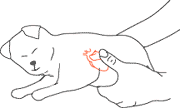|

 If a puppy is born and is not breathing, follow the cardiopulmonary resuscitation (CPR) directions outlined below. Have one person contact your veterinarian for help. If a puppy is born and is not breathing, follow the cardiopulmonary resuscitation (CPR) directions outlined below. Have one person contact your veterinarian for help.
-
Clear the airway. Hold the puppy's head downward to allow gravity to help drain fluid from the mouth, throat, and lungs. Use a suction bulb to remove any fluid from the airway.
-
Give two or three little puffs of air into the puppy's mouth and nose. In order to do this, your mouth needs to close around the puppy's mouth and nose. Do not give large breaths, as the puppy's lungs can be easily damaged. Be aware that some diseases such as Brucellosis may result in weak or dead puppies and may be transmitted to humans through contact with the puppy or fluids.
-
Check for a heartbeat; feel the chest wall between your fingers or use a stethoscope. If no heartbeat is found, compress the chest in the area right at the back of the bent elbow. This is the approximate location of the heart. Press the chest between the thumb and forefinger. Compress quickly. Remember a newborn puppy's normal heart rate is 120-180+ beats per minute.
Every 15-20 seconds, give another couple puffs of air.
Each minute check for a heartbeat/breathing. If the heart is beating slowly, stimulate the puppy by rubbing it roughly (but carefully) with a towel, turning it over in your hands, or holding it by its scruff. This puppy needs stimulation and may need you to give it a few breaths of air in order for it to live. Continue to work with this puppy for 20 minutes to see if it can be saved.
If the heart is not beating, continue the CPR for about 5 minutes. If the puppy is not alive and active by then, it is unlikely the puppy will be saved.
Veterinary & Aquatic Services Department, Drs. Foster & Smith, Inc.
Web Site

|